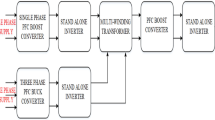Abstract
In this paper, a unique fifth-order converter consisting of one Boost and one SEPIC converter designed for dc grid application. This converter is suitable to draw power from two dc sources simultaneously and individually. It has two-switches that is used to fulfill the load power requirement with a minimum ripple in source current. The proposed multi-input converter (MIC) suitability is confirmed by experimental and simulation results performed in three different modes of operations. The decentralized voltage-mode and current-mode controllers are designed to ensure the constant load voltage and source current. A 48 V 150 W prototype MIC is developed in the laboratory. Dynamic performance and steady-state performance, along with simulation results, are compared with the experimental work. The PSIM and MATLAB software are used for simulation and analysis purposes. A dsPIC33FJ64GS610 micro-controller-based prototype has been developed in the laboratory for experimental results.













source working



source 2 is supplying power to load alone


Similar content being viewed by others
References
Y.C. Liu, Y.M. Chen, A systematic approach to synthesizing multiple-input dc-dcconverter. IEEE Trans. Power Electron. 24(1), 116–127 (2009)
Z. Wang, Q. Luo, Y. Wei, D. Mou, X. Lu, P. Sun, Topology analysis and review of three-port DC/DC converters. IEEE Transactions on Power Electronics 35, 11783–11800 (2020)
Y. Jeong, J.-D. Park, R. Rorrer, K.-W. Kim, B.-H. Lee. A novel multi-input and single-output DC/DC converter for small unmanned aerial vehicle, in 2020 IEEE Applied Power Electronics Conference and Exposition (APEC). IEEE, pp. 1302–1308 (2020)
Z. Shan, X. Ding, J. Jatskevich, K. TseChi, Synthesis of multi-input multi-output DC/DC converters without energy buffer stages. IEEE Trans. Circuits Syst. II Express Briefs 68, 712–716 (2020)
S. Athikkal, A three input DC-DC converter for hybrid energy application. Int J Electric EngTechnol 11(4), 72–79 (2020)
B. Zhu, Hu. Hui, H. Wang, Y. Li, A multi-input-port bidirectional DC/DC converter for DC microgrid energy storage system applications. Energies 13(11), 2810 (2020)
D. Chen, H. Zeng, A buck type multi-input distributed generation system with parallel-timesharing power supply. IEEE Access 8, 79958–79968 (2020)
R. Amaleswari, M. Prabhakar, Non-isolated multi-input DC-DC converter with current sharing mechanism. Int. J. Electron. 108, 1–27 (2020)
K. Varesi, S.H. Hosseini, M. Sabahi, E. Babaei, Modular non-isolated multi-input high step-up dc–dc converter with reduced normalised voltage stress and component count. IET Power Electron 11(6), 1092–1100 (2018)
S. Athikkal, K. Sundaramoorthy, A. Sankar, Development and performance analysis of dual-input DC–DC converters for DC microgrid application. IEEJ Trans. Electr. Electron. Eng. 13(7), 1034–1043 (2018)
K. Varesi, S.H. Hosseini, M. Sabahi, E. Babaei, A high-voltage gain nonisolatednoncoupled inductor based multi-input DC-DC topology with reduced number of components for renewable energy systems. Int. J. Circuit Theory Appl. 46(3), 505–518 (2018)
H. AboReada, S. S. Williamson, V. Sood, Analysis and control of multi-input, single-output, non-isolated DC/DC converter for effective renewable energy management, in 2019 IEEE Transportation Electrification Conference and Expo (ITEC), pp. 1–6. IEEE (2019)
O. Al-Naseem, R. W. Erickson, P. Carlin, Prediction of switching loss variations by averaged switch modeling, in Proc. IEEE Applied Power Elec. Conf. Rec., New Orleans, USA, pp. 242–248 (2000)
Z. J. Shen, Y. Xiong, X. Cheng, Y. Fu, P. Kumar, Power MOSFET switching loss analysis: a new insight, in Proc. IEEE Industry Appl. Conf., Tampa, FL, pp. 1438–1442 (2006)
L. Peng, Y. Kang, X. Pei, J. Chen, A novel PWM technique in digital control. IEEE Trans. Industr. Electron. 54(1), 338–346 (2007)
Datasheets of Driver Circuit I.C IR2110, Opto isolator 6N137, Diode MUR 1560, MOSFET IRFP250N.
dsPIC33FJ64GS610 reference manual, Microchip (2010).
Author information
Authors and Affiliations
Corresponding author
Additional information
Publisher's Note
Springer Nature remains neutral with regard to jurisdictional claims in published maps and institutional affiliations.
Rights and permissions
About this article
Cite this article
Tewari, V.K., Verma, A. Two-Loop Controlled Quasi Multiple-Input DC-–DC Converter for Load Voltage and Source Current Management. Trans. Electr. Electron. Mater. 23, 72–80 (2022). https://doi.org/10.1007/s42341-021-00320-5
Received:
Revised:
Accepted:
Published:
Issue Date:
DOI: https://doi.org/10.1007/s42341-021-00320-5




